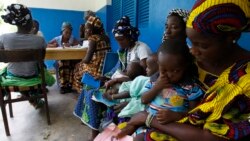Maternal mortality is one of the leading causes of death among women of reproductive age in developing countries. Some 800 women die while giving life every day.
Each mother’s death is a tragedy and also has a negative impact on her family and community. If a baby survives a mother’s death in childbirth, the child’s own chances of living to the age of five are significantly lower. That child and any siblings are less likely to receive health care and to go to school, and the family as a whole is now more likely to suffer economic hardship.
In June 2012, then-Secretary of State Hillary Clinton announced "Saving Mothers, Giving Life", a partnership between the governments of the United States and Norway, the American College of Obstetricians and Gynecologists, Merck for Mothers, and Every Mother Counts campaign. The idea was to accelerate collective action in order to reduce global maternal mortality
Nearly all maternal deaths – 99 percent of them - occur in developing countries. Of those, 56 percent occur in sub-Saharan Africa. Saving Mothers, Giving Life partnership chose two countries in the region - Uganda and Zambia - for its pilot partnership program.
Eighteen months after the program’s start, the results are astonishing. Speaking on January 9th, at the unveiling of the first annual report detailing the program’s results, USAID Administrator, Dr. Rajiv Shah, said that in Uganda and Zambia, the program was specifically designed to target the biggest obstacles that put women and newborns at risk: the delays in seeking, reaching, and receiving good care.
“In just one year, maternal mortality declined by roughly a third in the districts we worked in, in Zambia and Uganda. The number of women who delivered in healthcare facilities shot up by 62 percent in Uganda.”
“These are extraordinary results, achieved in just one year of real change and effort,” said Dr. Shah. “They are remarkable, and we know that they can be scaled to larger levels.”
As then-Secretary of State Clinton said when announcing the Saving Mothers, Giving Life Partnership, “Surviving childbirth and growing up healthy should not be a matter of luck or where you live or how much money you have. It should be a fact for every woman everywhere.”
Each mother’s death is a tragedy and also has a negative impact on her family and community. If a baby survives a mother’s death in childbirth, the child’s own chances of living to the age of five are significantly lower. That child and any siblings are less likely to receive health care and to go to school, and the family as a whole is now more likely to suffer economic hardship.
In June 2012, then-Secretary of State Hillary Clinton announced "Saving Mothers, Giving Life", a partnership between the governments of the United States and Norway, the American College of Obstetricians and Gynecologists, Merck for Mothers, and Every Mother Counts campaign. The idea was to accelerate collective action in order to reduce global maternal mortality
Nearly all maternal deaths – 99 percent of them - occur in developing countries. Of those, 56 percent occur in sub-Saharan Africa. Saving Mothers, Giving Life partnership chose two countries in the region - Uganda and Zambia - for its pilot partnership program.
Eighteen months after the program’s start, the results are astonishing. Speaking on January 9th, at the unveiling of the first annual report detailing the program’s results, USAID Administrator, Dr. Rajiv Shah, said that in Uganda and Zambia, the program was specifically designed to target the biggest obstacles that put women and newborns at risk: the delays in seeking, reaching, and receiving good care.
“In just one year, maternal mortality declined by roughly a third in the districts we worked in, in Zambia and Uganda. The number of women who delivered in healthcare facilities shot up by 62 percent in Uganda.”
“These are extraordinary results, achieved in just one year of real change and effort,” said Dr. Shah. “They are remarkable, and we know that they can be scaled to larger levels.”
As then-Secretary of State Clinton said when announcing the Saving Mothers, Giving Life Partnership, “Surviving childbirth and growing up healthy should not be a matter of luck or where you live or how much money you have. It should be a fact for every woman everywhere.”

















